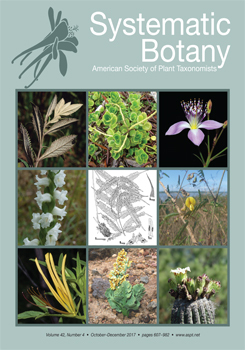The moonwort genus, Botrychium s. s., includes diploid and polyploid taxa that occur primarily in the northern hemisphere. Their evolutionary history, morphologically cryptic taxa and deep divergence of the family in the phylogeny of ferns has long fascinated pteridologists. Previous molecular studies did not include a complete taxonomic sampling of the taxa in the genus, nor multiple specimens from throughout the known geographical range of each taxon. Therefore, to investigate evolutionary relationships of the major clades of Botrychium s. s., we increased both taxonomic representativeness (multiple accessions per taxa), as well as phylogenetic resolution by including additional new chloroplast markers. To confirm identification and provide evidence from both maternal and paternal parentage of allopolyploids, we also included specimens that have been characterized by allozyme profiles determined by electrophoretic analysis of 20 nuclear enzyme loci for each taxon. We analyzed four chloroplast regions (matK intron, trnHGUG—psbA, andtrnLUAA—trnFGAA intergenic spacers, and rpL16 intron region) of 365 specimens fromAsia, Europe, North America, Oceania, and South America, sampling the geographical range of 34 of 35 accepted Botrychium s. s. taxa and thirteen putatively new taxa. We conducted a phylogenetic analysis of maternal lineages based on 2,385 aligned nucleotides using maximum likelihood and Bayesian inference to explore genetic diversity and phylogenetic relationships among taxa. We found strong support for themonophyly of three major clades: Lanceolatum, Lunaria, and Simplex-Campestre, and resolved 15 subclades. Our results suggest multiple origins for at least four polyploid taxa (B. boreale, B. michiganense, B. yaaxudakeit, and B. watertonense). The Simplex-Campestre clade had the largest number of species, despite having a similar total number of haplotypes as the Lunaria clade (62 and 59, respectively), which has the broadest worldwide distribution. In total, our new molecular phylogeny comprises 47 taxa, of which thirteen are discussed for possible taxonomic recognition.
How to translate text using browser tools
18 December 2017
A Worldwide Molecular Phylogeny Provides New Insight on Cryptic Diversity Within the Moonworts (Botrychium s. s., Ophioglossaceae)
Benjamin Dauphin,
Donald R. Farrar,
Alessio Maccagni,
Jason R. Grant
ACCESS THE FULL ARTICLE

Systematic Botany
Vol. 42 • No. 4
December 2017
Vol. 42 • No. 4
December 2017
cpDNA
cryptic species
fern
haplotype diversity
polyploid
taxonomy




